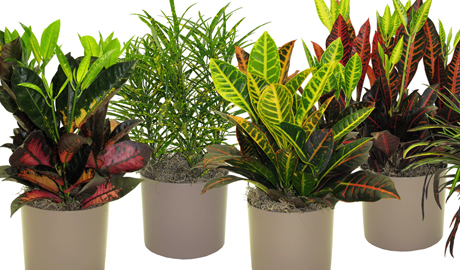Repotting Houseplants

Some indications your plant needs repotted:
Your houseplant is growing from the top, but the bottom leaves are turning yellow and dropping off, the leaf size may be smaller, and there are roots coming out of the drainage hole. There may be roots covering the surface of the soil. The plant wilts shortly after watering or it requires frequent watering. The water may even run directly down the sides of the pot. It’s definitely time to transplant into a larger pot. Repotting should be done during spring and summer when the plant is actively growing. Do not repot ailing or dormant plants or those with flower buds or open flowers.
Choose a pot one or two inches larger in diameter. With each inch increase in the diameter of the pot, the volume of the soil nearly doubles. For example, a four inch diameter pot holds two and a half cups of soil; a five inch pot holds four and a half cup. If a plant is repotted into too large a pot, the root system is surrounded by a large volume of soil which can become excessively moist and be slow to dry out. This can lead to root rot.
Steps to repotting:
1. Water the plant to be repotted several hours before the operation to be sure it is slightly moist. To remove it from the old pot, support the plant by placing your hand over the top of the soil with the stem between your fingers. Tip the pot upside down and slide the root ball out of the pot. You may need to tap the rim of the pot gently with a knife or other tool.
2. If the plant still won’t come out, slide the blade of a knife between the outside of the soil and the inside of the pot, then slide the plant – roots, soil and all – out of the pot.
Cover the drainage hole of the new pot with a piece of plastic window screen that has been cut to fit the bottom of the pot. A reversed chard of a clay pot can also be used. This filter will prevent the soil from washing out the hole when you water. It will also keep out insects. There is no need to cover the bottom of the pot with broken pieces of pottery or pebbles if it has a drainage hole.
4. Wet the growing medium before using it, preferably a day in advance. Place an inch or so of fresh soil in the bottom of the pot and firm it into place. Set the plant back in the pot to check the depth. You want to leave an inch of space from the rim to the top of the soil to allow for watering. Add or remove soil from the bottom of the pot, as necessary, to achieve the proper height. Never pile soil up around the stems at the base of the plant. Keep the plant at the same level as it was in the original pot.
5. Gently disturb the root system with your fingers so that the roots are headed outward from the root ball. If the roots are very tight and compact in the pot, and you cannot pull them apart, score the root ball with a knife to loosen them. If roots are wound around the bottom of the root ball, pull them apart and cut off excessive amounts.
Place the root ball in the pot and fill in around the sides of the root ball with potting soil. Add the soil with your hands or a trowel. Tamp in the new soil gently as you go, until you reach the top of the root ball. A chopstick is a good tool. Press your fingers gently into the top of the soil and tap the pot several times on the tabletop to settle the contents. Add more soil if necessary.
If you cut off some of the rootball to make it fit the pot better, it is a good idea to trim the plant back a bit to compensate for the root loss.
6. Water the plant to settle the roots in place by immersing the entire pot in a bucket of water or a sink for 30 minutes to 1 hour. If you use a watering can, run water through the drainage hole a least three times. This is done only when transplanting and when the plant has been allowed to completely dry out.
When taking care of your plants, they should never be allowed to sit in water. Remove the standing water from the saucer after watering, or fill the saucer with gravel so that the plant sits up, out of the water.
Do not fertilizer the plant until you begin to see new growth.
It is important to have everything close at hand before you start so that the roots don’t dry out during the transplanting process.
